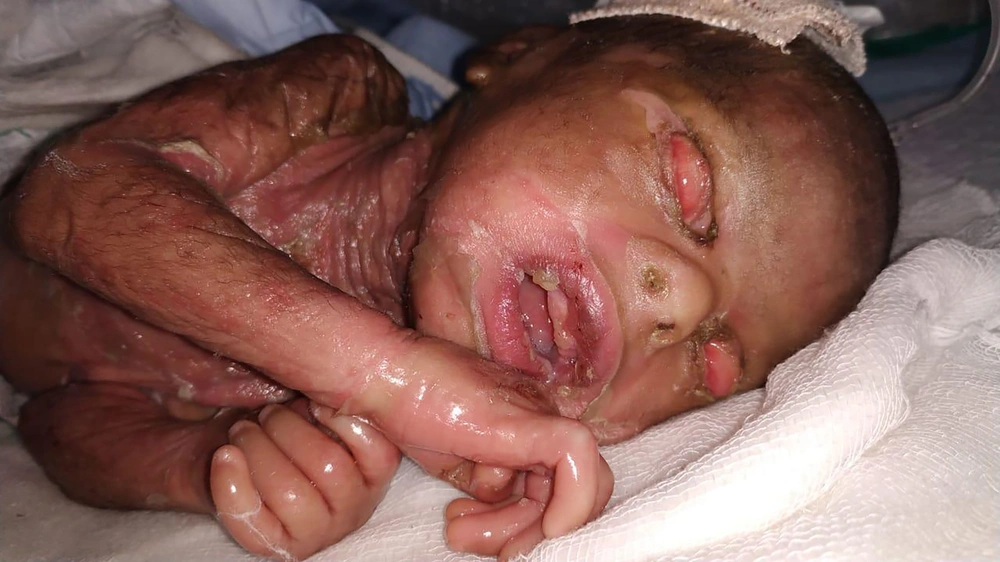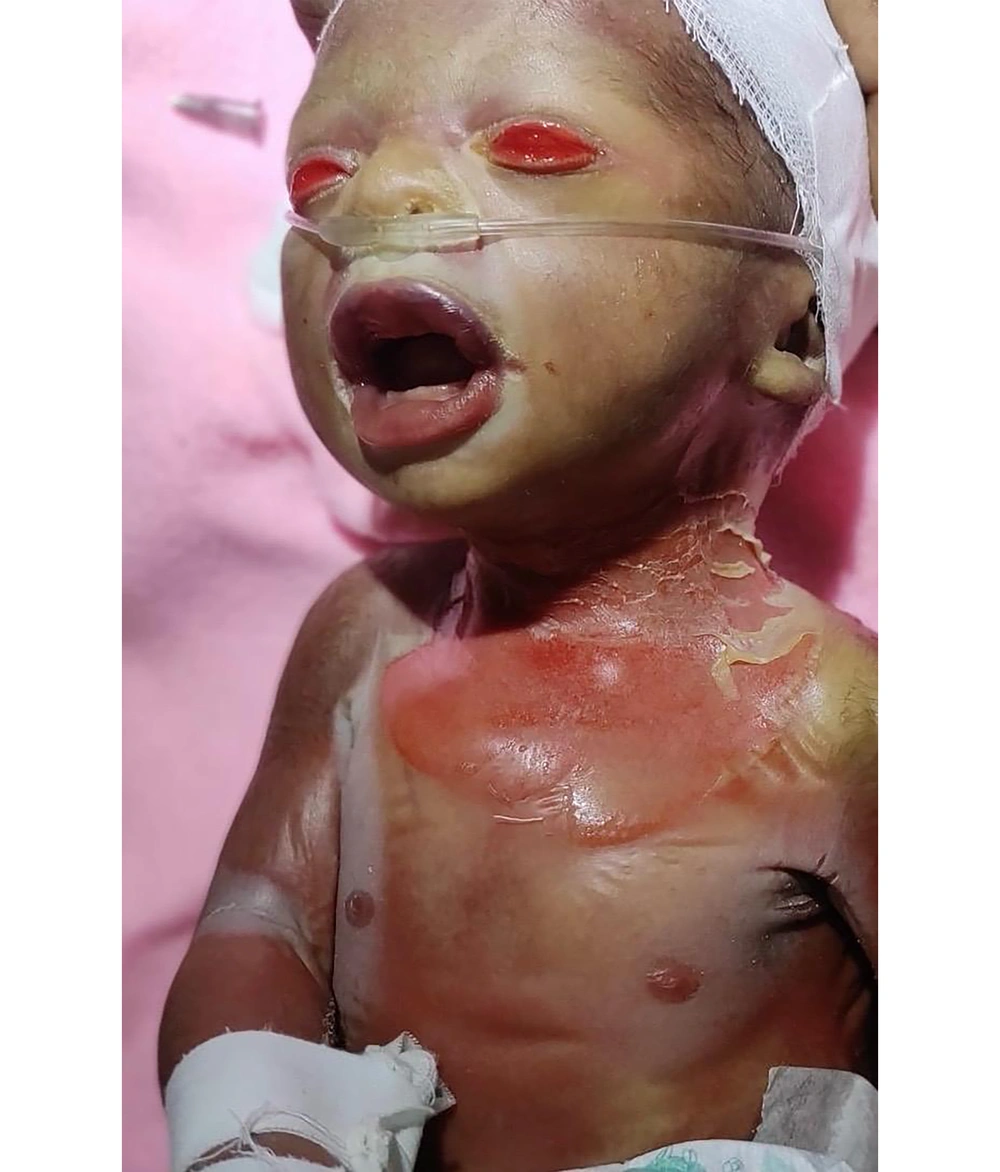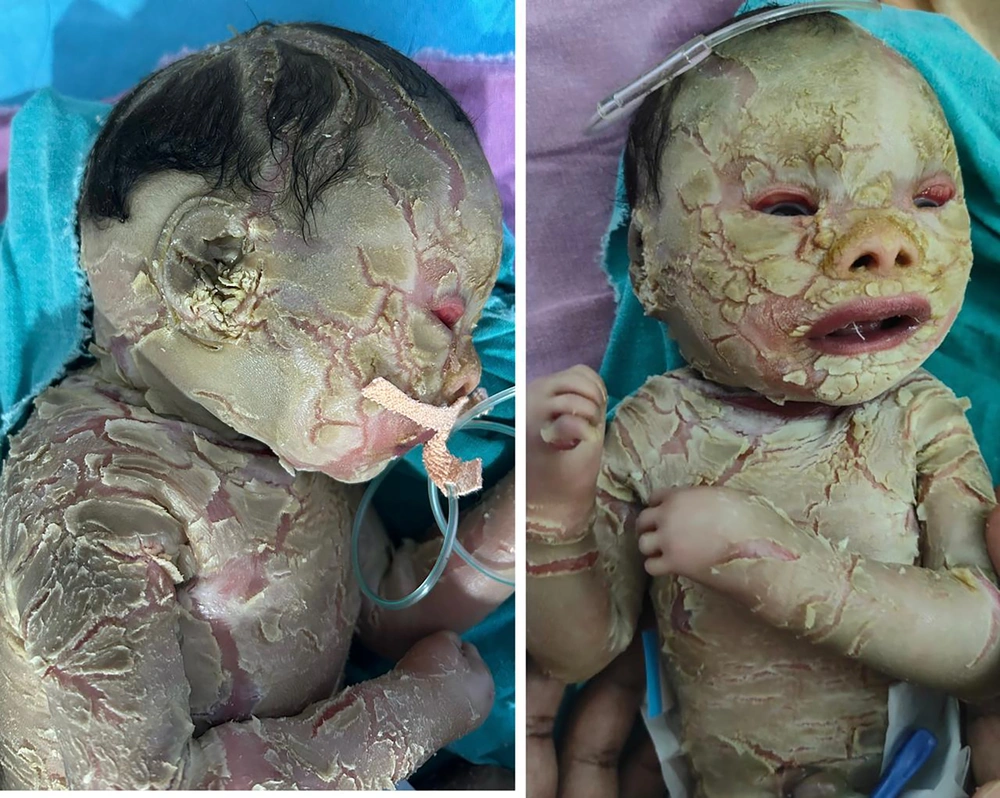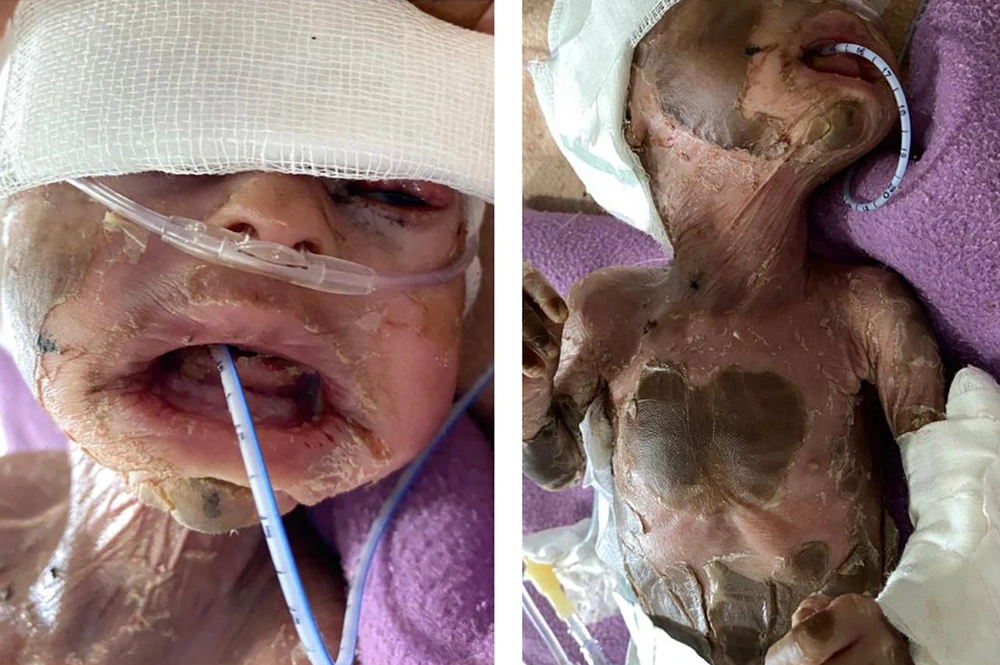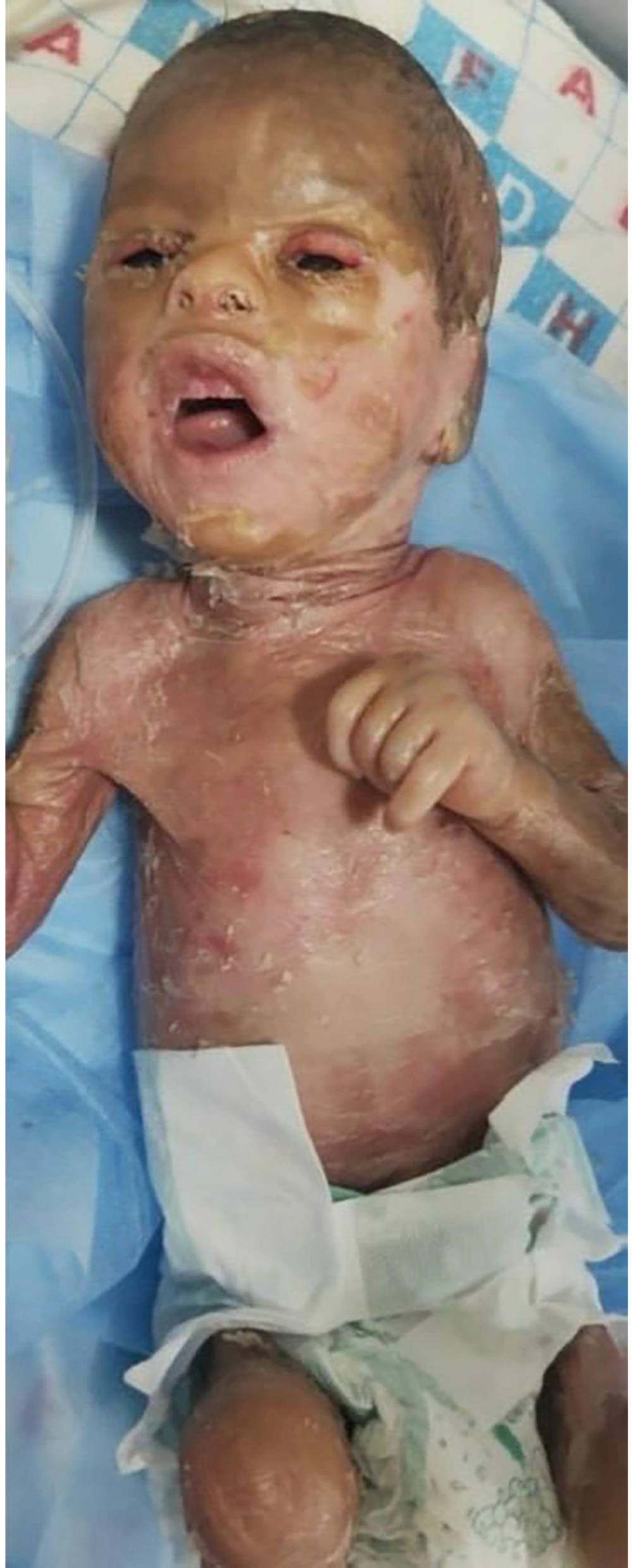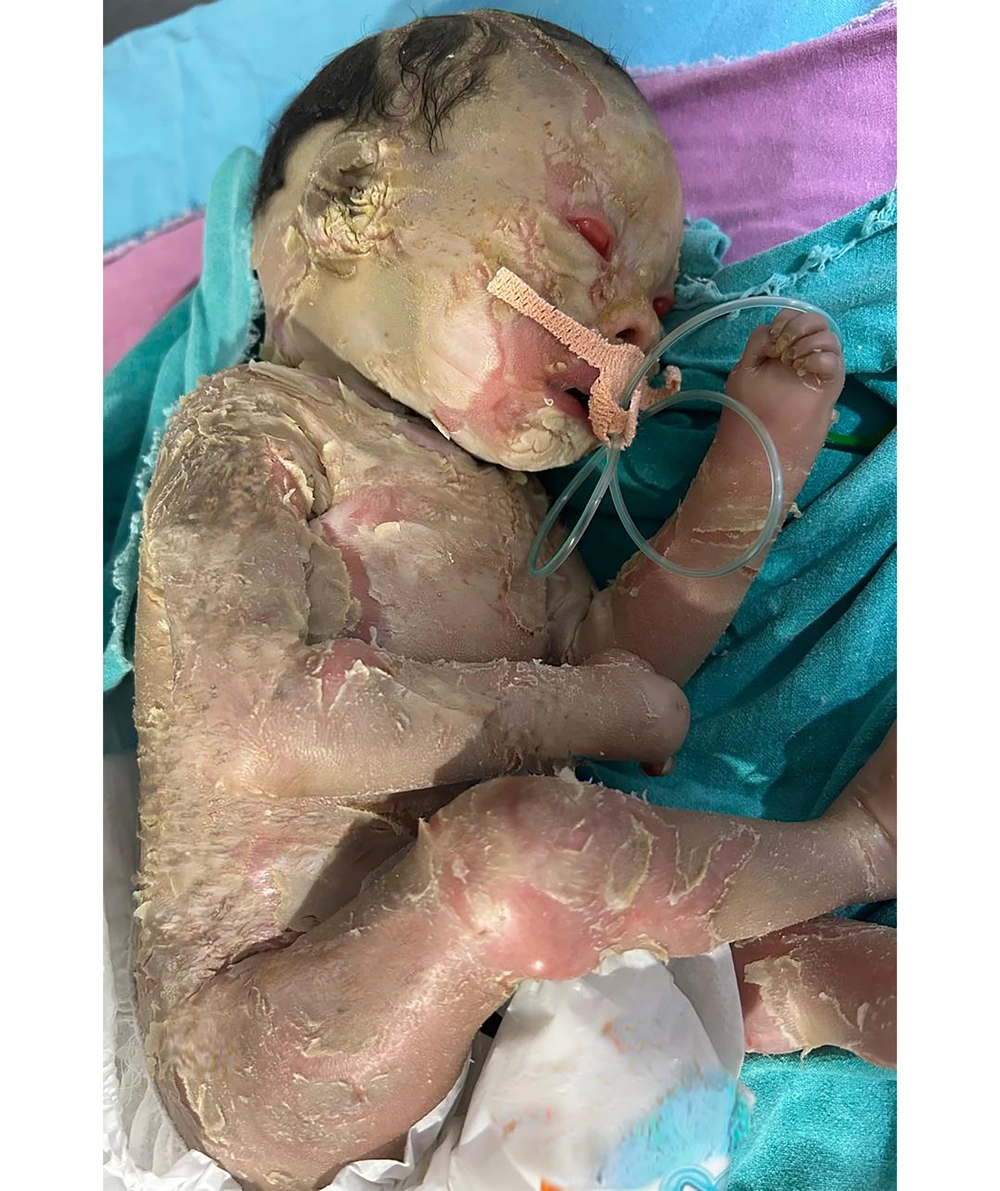1. Introduction
Ichthyoses are a group of disorders under the broad category of disorders of keratinization, which include a wide spectrum of conditions varying in etiology, onset, intensity, and extent of involvement, with the common feature being abnormal keratinization. This ultimately leads to impaired barrier function of the skin (1). The term "collodion baby" was coined by Hallopeau and Watelet. It is a congenital condition characterized by the presence of a parchment-like taut membrane covering the whole body (2). The incidence of collodion baby is reported to be 1 in 3,000,000 live births (3). The collodion membrane sheds over 2 - 4 weeks, eventually revealing an underlying ichthyosis. However, desquamation of the membrane leaves the baby susceptible to infections, temperature instability, and excessive fluid loss, leading to high mortality associated with the condition (4).
Isotretinoin is a first-generation systemic retinoid approved by the FDA in 1982 to treat severe, resistant, nodular acne that is unresponsive to conventional therapy (5). Various genes could be mutated in congenital ichthyosis, such as TGM1, ABCA12, and ALOX3. Retinoids work in ichthyosis by binding to retinoic acid receptors (RARs and RXRs) and then regulating gene transcription and protein expression. We report cases of three severe collodion babies managed with oral isotretinoin, with the contents of the capsule dissolved in honey and administered orally, leading to the prevention of mortality and significant improvement.
2. Case Presentation
2.1. Case 1
A male child, gestational age 30 weeks, born of a non-consanguineous marriage with a birth weight of 3 kg, was found to be encased in a shiny, parchment-like membrane at birth, associated with ectropion and eclabium (Figure 1). Generalized edema was noted. The baby was immediately admitted to the neonatal intensive care unit and thoroughly investigated. Lab abnormalities included a raised total leukocyte count of 19,000/microliter predominated by polymorphs, deranged serum electrolytes, and hypoproteinemia.
2.2. Case 2
Another male child of 28 weeks gestational age and birth weight of 2.5 kg had thick scales all over the body, predominantly over the head, trunk, and arms. There was an abnormal parchment-like membrane covering the body, associated with ectropion and eclabium, giving a typical fish-like appearance around the mouth. The newborn had generalized erythema and edema over the body (Figure 2). Investigations revealed a raised total leukocyte count of 21,000/microliter, deranged serum electrolytes, and raised blood urea nitrogen levels.
2.3. Case 3
A 39 weeks gestational age male child of birth weight 3.1 kg was born of a consanguineous marriage with thick yellowish scales and erythematous fissures covering the entire body (Figure 3A and B). Significant eclabium and generalized edema were noted, and investigations revealed a raised total leukocyte count of 28,000/microliter, raised ESR, hypoproteinemia, and deranged serum electrolytes.
The neonates were diagnosed as cases of severe collodion babies. They were admitted to the neonatal intensive care unit and managed with adequate humidification in an incubator, as increased trans-epidermal water loss, dehydration, hypernatremia, and decreased body temperature were of concern, posing poor prognostic factors. The neonates were managed by correcting fluid electrolyte imbalance, using artificial tears, and applying topical bland emollients. Definitive management was with isotretinoin capsules (5 mg), contents dissolved in sterile honey and administered orally at a dose of 1 mg/kg/day, which equated to 3 mL, 2.5 mL, and 3.1 mL per day, respectively, for the three collodion babies. The ectropion and eclabium decreased in severity over a span of 2 weeks. Honey was chosen as a suitable vehicle due to its easy availability, stability, and ease of administration to the baby. Additionally, it aligns with the traditional Indian ritual of administering honey to newborns to prevent the evil eye, making this method more acceptable to the parents.
Figure 4A and B shows progression in case 1 over a span of 2 weeks while on isotretinoin. Figure 5 shows desquamation and significant reduction in edema in case 2. Figure 6 shows improvement in scaling and fissuring in case 3 while being under treatment with isotretinoin along with other supportive measures over a span of 2 weeks. The outcome was uneventful in cases 1 and 2; however, unfortunately, we could not prevent the mortality of the third neonate due to a delay in presentation to the hospital. The treatment was initiated as soon as the baby was diagnosed, but severe electrolyte imbalance and raised total count at the time of presentation posed a major hurdle. In case numbers 1 and 2, despite both babies being preterm with severe collodion presentation, mortality could be prevented due to rigorous efforts made by the dermatologists and neonatologists combined. All routine investigations were carried out daily with strict monitoring of total count, liver function tests, serum electrolytes, and lipid profile to look for complications in the course of the disease as well as to monitor adverse effects of isotretinoin.
3. Discussion
Collodion baby refers to a newborn with a parchment-like membrane covering the entire body. The conditions that present as collodion baby are mostly harlequin ichthyosis, lamellar ichthyosis, and non-bullous ichthyosiform erythroderma. These types have an autosomal recessive mode of inheritance and are classified under autosomal recessive congenital ichthyosis (ARCI). The five genes whose mutations are implicated include transglutaminase 1 (TGM1), ABCA12, ichthyin/NIPAL4, and two lipoxygenase genes, ALOXE3 and ALOX12B (6).
The various pathogenetic mechanisms include members of the ABCA subfamily, which are all implicated in lipid transport. Deficient ABCA12 function causes lipid transport disorders in lamellar bodies, leading to a decrease in intercellular lipid levels in the stratum corneum. Mutation in the NIPAL4 gene is characterized by abnormalities in the lamellar bodies and the presence of elongated perinuclear membranes in the stratum granulosum (7). Retinoids work in ichthyosis by binding to retinoic acid receptors (RARs and RXRs) and regulating gene transcription and protein expression, thereby correcting the aberrant keratinization.
Collodion baby is associated with ectropion, eclabium, anonychia, hypotrichosis, hypoplastic cartilage, and pseudo-contractures leading to limited joint mobility. The membrane eventually detaches in 3 - 4 weeks, usually revealing an underlying permanent ichthyosis. Due to the impaired barrier function of the skin, trans-epidermal water loss can be more than six-fold greater than that of normal skin. Newborns with a collodion membrane are at risk for dehydration, hypothermia, electrolyte imbalance, respiratory difficulties, and infections. The most common causes of death are dehydration and septicemia. Prompt management of the baby in a humidified incubator and correcting fluid electrolyte imbalance is considered essential. The collodion membrane sheds off in 2 - 4 weeks after birth, revealing the underlying skin condition. Sometimes, spontaneous resolution may occur without any associated congenital anomaly in 10% of cases. Approximately 75% of these cases develop an ARCI, such as lamellar ichthyosis or congenital ichthyosiform erythroderma. In the remaining 15% of cases, syndromic associations exist (8).
Management of this condition requires a multidisciplinary approach with the combined efforts of a dermatologist, neonatologist, and ophthalmologist (9). Retinoids correct the aberrant keratinization that leads to the pathology in collodion babies. Acitretin is highly effective, but given the resource restrictions in developing countries, isotretinoin is an excellent alternative compared to acitretin due to its easier availability, lower cost, and appropriate outcomes, successfully preventing mortality in severe collodion babies (10).
3.1. Conclusions
In light of our case, we recommend the early use of retinoids in collodion babies, as they can have a dramatic effect on the prognosis of this condition, thereby preventing mortality in these neonates. Given the cost constraints associated with acitretin in a developing country like India, we suggest that isotretinoin could serve as an effective alternative at a relatively lower cost and with greater ease of availability.

